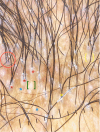Dermoscopy of Traction Alopecia in Black Scalp Patients: Insights from a Literature Review
- PMID: 40401872
- PMCID: PMC12090924
- DOI: 10.5826/dpc.1502a4578
Dermoscopy of Traction Alopecia in Black Scalp Patients: Insights from a Literature Review
Abstract
Introduction: Traction alopecia (TA) is a form of hair loss from excessive tension due to specific hairstyling practices. It disproportionately affects black women, including children.
Objective: Our study aimed to review the trichoscopy of TA.
Methods: A literature search was performed in the scientific database PubMed for articles published between 1958 and 2023, using the terms "traction alopecia," "black scalp," "trichoscopy," and "dermoscopy."
Results: The most frequent findings were vellus hair, hair casts, black dots, broken hairs, and white dots. Reduction in hair density, hair diameter variability, empty follicle openings, and vellus hairs may appear early or later during the disease course.
Conclusions: Trichoscopy is a crucial diagnostic tool if associated with a suggestive clinical history. Despite non-specific, its common clinical findings offer relevant information about the disease's progress.
Conflict of interest statement
Figures





Similar articles
-
Evaluation of clinical signs and early and late trichoscopy findings in traction alopecia patients with Fitzpatrick skin type II and III: a single-center, clinical study.Int J Dermatol. 2017 Aug;56(8):850-855. doi: 10.1111/ijd.13599. Epub 2017 Mar 30. Int J Dermatol. 2017. PMID: 28369851
-
Trichoscopy update 2011.J Dermatol Case Rep. 2011 Dec 12;5(4):82-8. doi: 10.3315/jdcr.2011.1083. J Dermatol Case Rep. 2011. PMID: 22408709 Free PMC article.
-
Clinical Significance of Trichoscopy in Common Causes of Hair Loss in Children: Analysis of 134 Cases.Int J Trichology. 2018 Jul-Aug;10(4):154-161. doi: 10.4103/ijt.ijt_101_17. Int J Trichology. 2018. PMID: 30386074 Free PMC article.
-
[Translated article] Trichoscopy in Alopecia Areata.Actas Dermosifiliogr. 2023 Jan;114(1):T25-T32. doi: 10.1016/j.ad.2022.08.027. Epub 2022 Nov 8. Actas Dermosifiliogr. 2023. PMID: 36368582 Review. English, Spanish.
-
Trichoscopy of Androgenetic Alopecia: A Systematic Review.J Clin Med. 2024 Mar 28;13(7):1962. doi: 10.3390/jcm13071962. J Clin Med. 2024. PMID: 38610726 Free PMC article. Review.
References
Publication types
LinkOut - more resources
Full Text Sources
